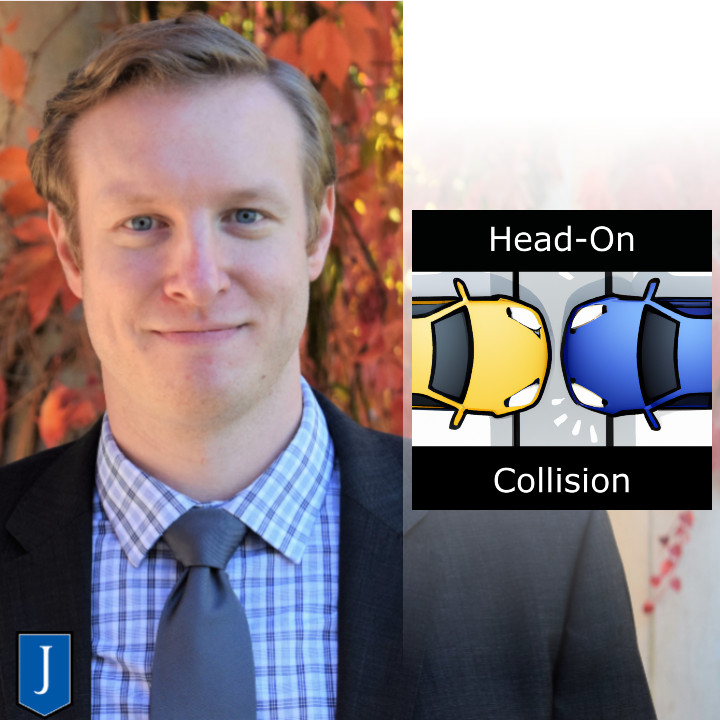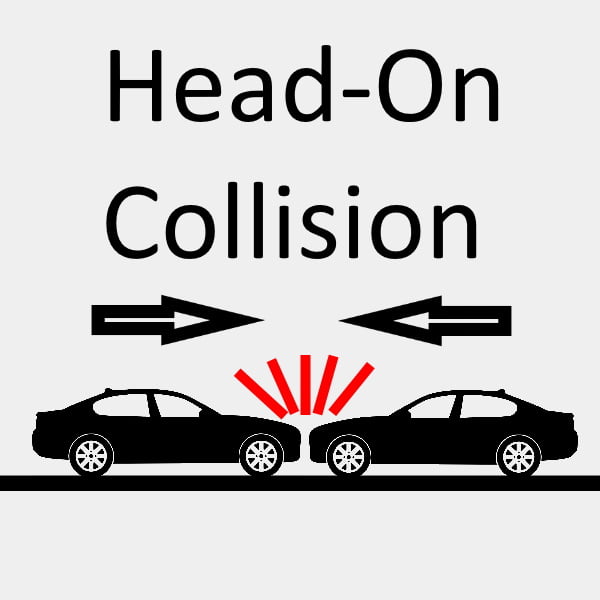Head-On Collision Lawyer
Get the help you need from a head-on collision lawyer. Learn your options, and get the financial and physical you rightfully deserve. Head-on collisions have special considerations. The specific type of injuries involved and liability concerns can be very important in your matter, and we are happy to review your case and let you know your options.
A head-on collision lawyer, often referred to as a personal injury attorney, specializes in representing individuals who have experienced car accidents, particularly those involving head-on collisions. These legal professionals possess extensive expertise in handling cases stemming from these severe types of accidents, which can lead to substantial injuries and property damage. Their primary role is to assist clients involved in such incidents in navigating the legal complexities and seeking compensation for the harm and losses they've endured.

Head-on Collision Settlements
Head-on collision lawyers know just how serious injuries can be from these accidents. The relative velocity of head-on collisions is usually the highest among all collision types. Property and more importantly people get severely damaged in head-on collisions. Settlements in head-on collisions depend on the details of the case.
Call us and tell us about your head-on collision to receive a free case review.
Is a head-on collision the worst possible crash?
Head-on collisions are in many ways the worst possible crash. Statistically, they are one of the deadliest types of car crashes. Cars are designed to reduce the severity of head-on collisions, but the physics involved are traumatic.
Head-on collisions are serious. They have a high potential for causing severe injuries or even fatalities. When two vehicles collide head-on, the combined speed of the vehicles doubles. The speed of an impact directly relates to how violent the impact is. Injuries are severe, and usually, both vehicles involved are totaled.
If you were in a head-on collision we think you really should consult with a personal injury attorney.
Head-On Collision
The severity of the injuries depends on several factors, including the speed of the vehicles at the time of impact, the size and weight of the vehicles, the use of safety equipment such as seatbelts and airbags, and the age and health of the occupants.

These factors will come into play during a personal injury case. Oregon actually has a law specifically covering liability in car accidents where the injured person wasn't wearing a seatbelt. You can still recover compensation in this scenario but it may be slightly reduced. Ask one of our attorneys about this during a free consultation.
Head-On Collision Injuries
Injuries that can occur in a head-on collision can include broken bones, head injuries, spinal cord injuries, internal injuries, and organ damage. The severity of these injuries can range from minor to life-threatening. Crumple zones and seatbelts can only do so much to protect you.
Receiving prompt treatment is important just as it is in any accident case. The severity of your injuries will impact the level of financial recovery you are entitled to. Often you won't even know how badly you're injured until seen by a medical professional.
It's important to note that head-on collisions are often caused by factors such as drunk driving, distracted driving, or driving on the wrong side of the road. Since these types of accidents are usually very avoidable determining negligence is usually straightforward in a head-on collision case. Someone is typically not following the law and is obviously at fault. Insurance companies may fight over fault, but that is where a personal injury lawyer can help you understand the strength of your case.
What happens during a head-on collision?
During a head-on collision, two vehicles traveling in opposite directions collide with each other front-end to front-end. This type of collision can result in significant damage to the vehicles involved, as well as serious injuries or even fatalities to the occupants. Often both vehicles involved are totaled. Fatality and injury severity are highly correlated with the speed of the collision.
When two vehicles collide head-on, the force of the impact can cause the vehicles to come to an abrupt stop, resulting in rapid deceleration of the occupants. This sudden deceleration can cause the occupants' bodies to move forward rapidly and then be thrust back, leading to injuries such as whiplash, spinal cord injuries, and head injuries. Since the functional crash speed can be so high obviously injury potential is high.
Slow Head-On Collisions
However, slower-speed collisions are common and non-life threatening but serious injuries can occur. Even when there are relatively minor injuries people often end up with whiplash. Additionally, the same crumple zones that protect the occupants, are difficult to repair. Older cars were made to be extremely rigid and actually were less damaged after a head-on collision. Unfortunately, this led to the people in the cars being much more injured. So while slow head-on collisions can be less injuring, you still might need an attorney to fight over receiving fair compensation for your damaged vehicle.
Head-On Collision Repercussions
How your injuries affect your day-to-day life can impact non-economic damages you may recover. Many people don't realize all of the compensation they are rightfully owed. That is part of how a personal injury lawyer can maximize your recovery.
The severity of a head-on collision depends on various factors, including the speed of the vehicles, the size and weight of the vehicles, the angle of the impact, and the use of safety equipment such as seatbelts and airbags. The faster the vehicles are traveling and the heavier they are, the more severe the impact is likely to be.
In addition to the physical impact of the collision, there is also the potential for secondary impacts, such as when occupants are thrown from the vehicle or when loose objects within the vehicle become projectiles. All of these factors can contribute to the severity of injuries in a head-on collision.
One overlooked aspect of head-on collisions is the pain and suffering people experience. These are truly traumatic events. After an accident, people are usually anxious to drive. This is especially true with head-on collisions. The memory of having a car come directly at you can stay with you for life affecting your well-being every single time you drive.
What is an example of head-on collision?
An example of a head-on collision would be when two vehicles traveling in opposite directions on a two-way road collide with each other front-end to front-end. For instance, imagine one driver is distracted by their phone and crosses the centerline. Subsequently, the driver enters the lane of oncoming traffic, resulting in a head-on collision with another vehicle. These accidents happen all the time. Head-on collisions are common on undivided highways.
Anywhere you see a "Do Not Enter" Traffic sign is another potential place for head-on collisions to occur. For example, a head-on collision could occur on a one-way road if a driver travels the wrong way down the road and collides head-on with a vehicle traveling in the correct direction. Common places for this include intersections or on highway exits and entrance ramps if a driver enters the wrong way.
In both scenarios, the impact of the collision can be severe, resulting in significant damage to the vehicles and serious injuries to the occupants involved. Drivers are always supposed to follow traffic laws and pay attention to the road to prevent head-on collisions from happening. However, accidents do happen. That is where we can help.
What do you do after a head-on collision?
After a head-on collision, it's important to take certain steps to ensure the safety of everyone involved and to document the accident for insurance and legal purposes. To make sure you're protecting your legal rights you should consider talking to a car accident lawyer. Consultations are free and can really help reduce the stress of having so many unanswered questions.
Here are some helpful steps to do after a head-on collision:
- Check for injuries: The first thing to do after a head-on collision is to check yourself and others for injuries. Call for emergency medical assistance immediately if anyone is injured.
- Move to a safe location: If possible, move your vehicle to a safe location off the road to avoid the risk of another collision. Turn on your hazard lights to warn other drivers.
- Call the police: Even if the accident seems minor, it's important to call the police and report the accident. They will document the accident and create an accident report that you can use for insurance purposes.
- Exchange information: Exchange contact and insurance information with the other driver(s) involved in the accident. Get their name, phone number, driver's license number, and insurance information.
- Document the scene: Take pictures of the damage to your vehicle and any other vehicles involved in the accident. Also, take pictures of the surrounding area, including any skid marks or debris.
- Notify your insurance company: Call your insurance company and report the accident as soon as possible. Provide them with the details of the accident and any other information they need.
- Seek medical attention: Even if you don't feel injured right away, it's important to get a medical checkup as soon as possible after the accident. Some injuries may not be immediately apparent, and it's important to get proper treatment.
- Protect Your Rights: These steps are valuable things to do after an accident but do not cover all of your needs. To fully protect yourself you need to know all of your legal rights. Every case is unique. We recommend talking to an attorney. Get a consultation and you will get advice tailored to your exact circumstances.
Remember, safety is the top priority after a head-on collision. Stay calm, follow these steps, and seek assistance if needed.
What Does A Head-On Collision Lawyer Do?
Head-on collision lawyers typically handle a wide range of legal issues related to their client's case including:
Investigating the accident: A head-on collision lawyer will work to gather evidence and determine the cause of the accident. This may involve reviewing police reports, interviewing witnesses, and inspecting the vehicles involved in the accident.
Determining liability: A head-on collision lawyer will also work to determine who is liable for the accident. This may involve identifying all of the parties involved in the accident and determining their role in causing the collision.
Negotiating with insurance companies: A head-on collision lawyer will often need to negotiate with insurance companies to obtain fair compensation for their clients. This may involve negotiating a settlement or taking the case to trial if a settlement cannot be reached.
Representing clients in court: If a settlement cannot be reached, a head-on collision lawyer may need to represent their clients in court. This may involve preparing and presenting a case, cross-examining witnesses, and making legal arguments on behalf of the client.
What are common injuries in a head-on collision?
Head-on collisions are some of the most severe types of car accidents, and they can result in a range of serious injuries. Some common injuries that may occur in a head-on collision include:
- Traumatic brain injuries: Head-on collisions can result in traumatic brain injuries, such as concussions, contusions, and skull fractures. These types of injuries are often life-threatening and may require extensive medical treatment and rehabilitation. However, many people experience traumatic brain injuries and do not get the treatment they need as the injury is not properly diagnosed.
- Spinal cord injuries: Head-on collisions can also result in spinal cord injuries, which can cause paralysis. Other permanent disabilities such as incontinence and chronic pain can also occur. These types of injuries can be particularly serious and may require ongoing medical care and support.
- Broken bones: Head-on collisions can cause serious fractures to the bones in the body, including the arms, legs, ribs, and skull. These types of injuries can be extremely painful and may require surgery and other medical treatment.
- Internal injuries: Head-on collisions can cause internal injuries, such as damage to the organs or internal bleeding. These types of injuries may not be immediately apparent and may require surgery or other medical treatment to repair.
- Soft tissue injuries: Head-on collisions can also result in soft tissue injuries, such as bruises, strains, and sprains. These types of injuries may not be as severe as some of the other injuries listed above, but they can still be painful and may require medical treatment.
Head-on collision injuries can be life-changing and may require extensive medical treatment and rehabilitation. As such, it is important to know your options if you were injured in a head-on collision. We may be able to help.
Call for a free consultation if you are facing a head-on collision personal injury claim.
We will review your case for free.
Pay us nothing unless we get you a better settlement.
We work on contingency.

